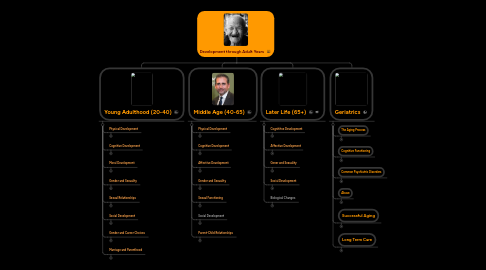
1. Young Adulthood (20-40)
1.1. Physical Development
1.1.1. Peak strength, flexibility, functioning and efficiency reached between 20 and 30
1.1.2. Poor health related to lifestyle choices and behaviors
1.1.2.1. Alcohol and substance abuse
1.1.2.2. Poor exercise and nutritional habits
1.2. Cognitive Development
1.2.1. Brain cell development peaks during the 20s
1.2.2. Intellectual functioning continues to evolve into an advanced phase of problem solving
1.2.2.1. Influenced by education, tolerance of diverse viewpoints, and dialectical thinking
1.3. Moral Development
1.3.1. Adhere to universal ethical principles
1.3.1.1. Abiding by social contract and respecting individuals rights
1.3.2. Increasing prosocial behavior, civic engagement, and a sense of purpose within society's standards of morality
1.4. Gender and Sexuality
1.4.1. Reproductive system fully mature by the age of 20
1.4.2. Discussion about comfort with intimacy is virtually unavailable and rarely addressed in clinical settings
1.4.3. Sexual identity and sexual orientation consolidate
1.4.4. Gay males define themselves as homosexual between ages 19 and 21
1.4.5. Lesbians reach self definition between ages 21 and 23
1.5. Sexual Relationships
1.5.1. At least 20% of young adults in their 20s and 30s do not marry
1.5.2. Unmarried relationships are short term, lasting about 2 years on average
1.5.3. Singlehood has its advantages
1.5.4. Women prefer to bear their children before age 45
1.6. Social Development
1.6.1. Major task of young adulthood is intimacy vs. isolation
1.7. Gender and Career Choices
1.7.1. Working inside vs. outside the home
1.8. Marriage and Parenthood
1.8.1. Joys of parenthood
1.8.2. Parenthood promotes a sense of true adulthood
2. Middle Age (40-65)
2.1. Physical Development
2.1.1. Loss of neurons and degeneration of neuronal pathways.
2.1.2. Skills lost, unless practiced.
2.1.3. Diminished ability to maintain homeostasis.
2.2. Cognitive Development
2.2.1. Overall intelligence declines at about age 30
2.2.2. "crystallized intelligence," which depends on education and experience, increases.
2.3. Affective Development
2.3.1. Reflection of life goals
2.3.2. Some distress over transition, while others are able to handle and learn from this crisis.
2.4. Gender and Sexuality
2.4.1. Women: Menstrual cycle becomes less regular in late 30's and 40's, ceases for most women during their 50's.
2.4.2. Men: Circulating level of testosterone declines with age.
2.4.3. Men: Developing an erection requires more time and stimulation.
2.5. Sexual Functioning
2.5.1. Frequency of sexual intercourse drops to 3-4 times/month for couples married 30 years.
2.5.2. Frequency is 2-3 times/month even at the age of 70
2.6. Social Development
2.6.1. Conflict of Generativity vs Stagnation.
2.6.2. Adults reevaluate their life goals- may lead to mid-life crisis.
2.6.3. Identity Crisis
2.7. Parent-Child Relationships
2.7.1. This is time when children move out, women lose the role of mother.
2.7.2. Boomerang effect can be fulfilling to the parents because they feel needed.
2.7.3. Consolidation, parents and children save resources and money by living together. This is more permanent.
2.7.4. This population is known as the sandwich generation- taking care of their children as well as their aging parents.
3. Later Life (65+)
3.1. Cognititve Development
3.1.1. Dementia
3.1.2. Alzheimer's
3.2. Affective Development
3.2.1. Anxiety
3.2.2. Loss
3.2.3. Depression
3.2.4. Suicide
3.2.5. Alcoholism
3.3. Gener and Sexuality
3.3.1. Female
3.3.1.1. Female
3.3.2. Male
3.3.2.1. Degeneration of Seminiferous Tubules
3.3.2.2. Testosterone Concentration
3.3.2.2.1. Medication
3.4. Social Development
3.4.1. Ego Integrity
3.4.1.1. Biggest threat = Isolation
3.4.2. Despair
3.4.3. Physical & Neurosensory Deterioration
3.4.4. Support Network
3.5. Biological Changes
3.5.1. Kidney Functions
3.5.2. Reduced Cardiac & Pulmonary Reserve
3.5.3. Neurnseosory system losses
3.5.4. Gastrointestinal System
4. Geriatrics
4.1. The Aging Process
4.1.1. Physiological changes
4.1.2. Sensory Sytem
4.1.3. Sleep distrubances
4.1.4. Alzheimer's
4.1.5. Secual health
4.1.6. HIV/AIDS
4.2. Cognitive Functioning
4.2.1. Dementia
4.2.2. Depression
4.3. Common Psychiatric Disorders
4.3.1. Depression
4.3.2. Anxiety
4.3.3. (PTSD)
4.3.4. Suicide
4.4. Abuse
4.4.1. Elder abuse
4.4.2. Substance abuse
4.4.3. Psyciatric treatments
4.5. Successful Aging
4.5.1. Retirement and Volunterrism
4.6. Long Term Care
4.6.1. Conservitive and creative options
4.6.2. Hospice
4.6.3. Respite care
